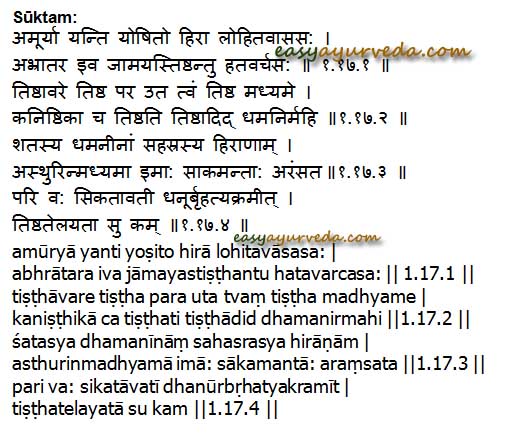Hymn To Stop Hemorrhage, Bleeding Through Capillaries
By Prof. Vd. Rangaprasad Bhat
Disclaimer: This article is only for the purpose of information. The article does not make any claim that the procedure explained would ensure the quoted benefits.
Rudhirasrāva nivartana dhamanībandhana sūkta –
Hymn for homeostasis in haemorrhage occurring due to rupture of capillaries or blood vessels :-
Table of Contents
Introduction
Hemorrhage means escape of blood from blood vessels into surrounding tissue. When a vessel is injured, hemorrhage continues as long as the vessel remains open and the pressure in it exceeds the pressure outside of it. Normally, coagulation closes the vessel and stops the bleeding.
Uncontrolled hemorrhage can result from anticoagulant therapy, hemophilia, or severe blood-vessel damage, leading to excessive blood loss.
Read related: Analysis Of Effect of Mantras On Health And Nadi
The following sūkta from Atharvana veda is indicated in cases of haemorrhagic conditions for healing of the ruptured dhamanis in regaining its lost structure. Chanting this mantra, along with appropriate medications, would help in supplementing the quicker rate of healing.
The ṛṣi empowering and emanating through this sūkta is brahmā ṛṣi. The devatā for this sūkta is yoṣit. The chandas meter adviced to chant this sūkta is anuṣṭup,1 bhūrik anuṣṭup, 4 tripadārvī gāyatrī.
Read related: Hymns For Cardiac Ailments, Jaundice, Fever
Sankalpa
Please note the classical sankalpa is a detailed one involving the mentioning of the time elements (like – ādhya brahmane, dvitīya parārdhe, śveta varāha kalpe, vaivasvatha manvantare, aṣṭaviṃśati kaliyuge, bauddhavatāre, śālivāhaṇa śākhe etc.,).
Followed by mentioning the geographical elements (like jaṃbudvīpe, merordakṣiṇa pārśve, bhāratavarṣe, bharatakhaṃḍe, godāvari dakṣiṇa tīre, mama svagṛhe, devatā sannidhau etc.,) – but this geographical elements mentioned is for the country India and could not be considered universal since the elements of location and direction will be differing from the above mentioned ones for other countries).
Following the above the time elements are to be mentioned during the sankalpa (which will be covering and addressed with the following factors – asmin vartamānena,—— samvatsare, ——- āyane, ——ṛtau,——–māse, ——pakṣe, ——-tithau, ——- vāsare, ——- nakṣattre, ——yoge, ——-karaṇe etc.,). Followed by mentioning of the element of lineage of one’s self (like ——-gotra jātasya, ———–nāmadheyasya,). And finally, followed by mentioning of the element of purpose like the desire or need or cause for chanting the mantra.
Since, the above form of detailed sankalpa is not possible for people who are non residents of India, for the purpose of practicability it can be said in the following shorter manner, as in this specific case of hemorrhagic conditions.
For the purpose haemostasis , I —– (so and so named person)——, of ———so and so rāshi and nakshatra ———–, here by – am chanting the following Rudhirasrāva nivartana dhamanībandhana sūkta for twelve times [or twenty eight or yatha shaktyā (as far as possible)].
Read related: Garbhadana Sukta: Hymn For Conception
It may, be noted that, without Sankalpa no objective can be accomplished. No remedies, pooja or karma yields results without Sankalpa.
Posture: Sukhāsana or Padmāsana.
Hymn

Interpretation
The red blood carrying (lohitavāsasa:) veins (hirā) in a women (yoṣito) get stabilised and stop (amūryā yanti) from bleeding, to avoid getting bereft of vigour and stamina (hatavarcasa:), as in the manner (iva) in which a sister (jāmaya)would stop leaving the house (tiṣṭhantu) without the company of her brother (abhrātara). || 1.17.1 ||
Let the blood flowing through the downward moving (तिष्ठावरे), upward moving (tiṣṭha para) and the (uta) one present inbetween the above two (tiṣṭha madhyame), along with the smaller (kaniṣṭhikā) and bigger sozed dhamanis get stabilised from flowing out excessively (tiṣṭhādid dhamanirmahi). ||1.17.2 ||
Let the hundreds of arteries (śatasya dhaman); the thousands of vein (sahasrasya hirāṇām) and those present in between (madhyamā) along with the ones present in the end of the body like the end artery (or terminal artery) simultaneously (imā: sākamantā:) by force stop the bleeding and get stabilised (asthurin – araṃsata). ||1.17.3 ||
[Dictionary meaning:- ināṃ= by force; asthu = √स्था (√sthā) – stopping, being restrained / nivṛtt; hirāṇām = veins; dhamanīnāṃ = arteries; imā: = all these; sākam = ind.(prob. fr. 7. sa- añc-; see sāci-) together, jointly, at the same time, simultaneously; araṃsata = to cause to stay, stop, set at rest.]
Hey great channels (bṛhati) carrying the blood, who are spread across the entire body , curved (tortuous) like the dhanush (bow), bestow this person with quick (su) wellness (kam) by stopping the flow (tiṣṭhate layatā)of blood. ||1.17.4 ||
Click to consult Prof. Vd. Rangaprasad Bhat








